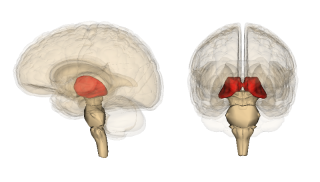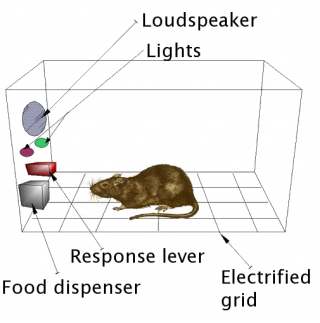Neuroscience
This Is How the Brain Filters Out Unimportant Details
We're bombarded by neural input from our environment. How is most of it ignored?
Posted February 11, 2015 Reviewed by Jessica Schrader

Guest post by Daniel Hass
At any given moment, we are constantly bombarded by signals from at least four of the five senses.
The visual system is constantly processing our surroundings. The auditory system is stimulated by all of the many minuscule sounds that compose our environment. We’re taking in all the smells around us at any given moment, and we’re constantly feeling the clothes on our skin. Even within one sensory system, there is an enormous amount of data that gets processed.
With this onslaught of input, how do we manage to not go completely insane? The key is that we pay attention to only a small proportion of that information and throw much of it away. This process is known as selective filtering or selective attention, and most people do it all the time. Imagine watching a movie at a theater. If you’re quite focused on the film, you’re probably not noticing the sound of squeaking seats, crunchy popcorn, or even the air conditioning whirring through the vents.
Although there are several regions of the brain involved in each sensation, the part of the brain involved in selective filtering is where all of these senses intersect.

This area of the brain is known as the thalamus. Classically, the thalamus is thought to be a kind of relay where sensory neurons meet and are sent to their destination in the cerebral cortex. The thalamus is also thought to be involved in consciousness; patients experiencing a stroke or other damage that affects the thalamus, for example, fall into permanent comas. However, these functions do not fully explain why, in addition to connections from the thalamus to the cerebral cortex, there are also connections from the cortex to the thalamus.
This “reciprocal” connectivity can be explained by selective filtering. When the cortex receives a type of information that it deems a priority (like focusing on the movie), it sends a signal back to a part of the thalamus known as the reticular nucleus. The structure uses the neurotransmitter GABA to inhibit transmission of other “irrelevant” signals from the thalamus to the cortex (the squeaky seats, popcorn, and air conditioning).
Selective filtering is interesting. But why is it important?
Research in selective filtering is critical not only because it tells us about normal biological processes in our brains but because it can impact certain individuals, such as those with schizophrenia. Schizophrenia is a disorder of the brain with a wide variety of symptoms, which include delusions, hallucinations, and disorganized behavior. People with schizophrenia also have deficits in auditory selective filtering and general attention. The biological basis for many of these symptoms, however, remains unknown.
A recent study in Nature Neuroscience by Ahrens studied how the selective filtering system functions by using a mouse that is deficient in the schizophrenia risk factor gene ERBB4. This gene produces a growth factor receptor and is expressed highly in the reticular nucleus, the area of the thalamus responsible for selective filtering.
To determine how ERBB4 deficiency alters selective filtering, Ahrens and colleagues used two different experimental paradigms to test selective filtering in mice. In the first paradigm, mice were rewarded if they could pick out an 8- or 20-kHz tone from a series of distracting tones between 5- and 20-kHz. This tested whether mice were able to filter out “noise” within one sensory modality.

In the second paradigm, mice were exposed to both tones and LED lights, and only mice responding to lights in specific positions on an array of LEDs were rewarded. This task determined whether mice could filter out distractors from different senses.
ERBB4-deficient mice were more likely to filter within one sense and performed better than wild-type mice on the first experimental task. However, they demonstrated difficulties in switching between different senses and performed worse on the second task.
This study demonstrated that by changing the expression of a gene that is altered in schizophrenia, the researchers altered the ability of mice to selectively attend sensory stimuli. This is because ERBB4 normally decreases the influence that the cortex has over the reticular nucleus. Without ERBB4, cortical feedback to the reticular thalamic nucleus is stronger, and thus there is greater suppression of irrelevant data both within a sensory modality (demonstrated by better selective attention to one sense) and between sensory modalities (demonstrated by impaired switching between visual and auditory tasks, the brain thinks that the auditory task is just more “noise”).
Although these symptoms do not perfectly mimic schizophrenia, they help us to understand the circuitry that underlies normal brain function. While this is just one piece of a larger puzzle, it is also necessary if we want to understand certain disorders associated with altered patterns in the brain.
References
Ahrens et al. (2015) ErbB4 regulation of a thalamic reticular nucleus circuit for sensory selection Nat. Neurosci., 18: 104–111
Lu et al. (2010) Support for the involvement of the ERBB4 gene in schizophrenia: a genetic association analysis, Neurosci. Lett., 481: 120–125
McAlonan et al. (2000) Thalamic Reticular Nucleus Activation Reflects Attentional Gating during Classical Conditioning, J. Neurosci, 20(23):8897–8901
Nicodemus et al. (2006) Further evidence for association between ErbB4 and schizophrenia and influence on cognitive intermediate phenotypes in healthy controls, Mol. Psychiatry, 11: 1062–1065




